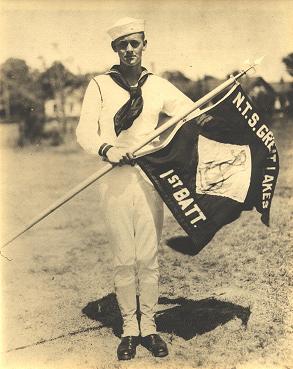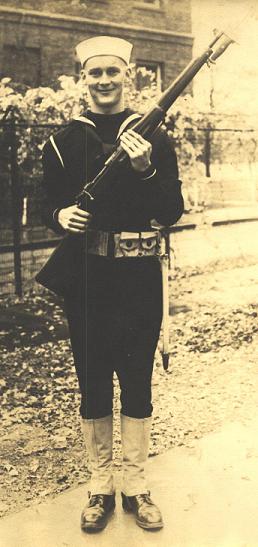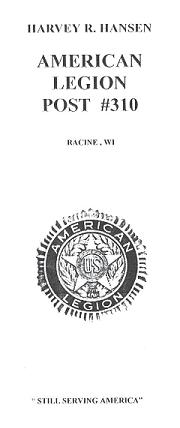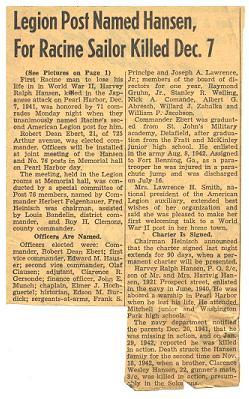
Harvey Ralph Hansen |
USS Arizona |

DATE: Fri 06-Dec-1991 PUBLICATION: JT CATEGORY: XX AUTHOR: km ILLUSTRATION: p LOCATION: 01 A Pearl Harbor All-American war casualty Racine family remembers brother who died in attack on Pearl Harbor photo by Mark Hertzberg (photo filed under Hansen, Harvey) Norman Hansen and Mabel Blum, and some of the memorabilia regarding their brother, Harvey Hansen, who died at Pearl Harbor. Norman Hansen is holding a letter to the family from President Roosevelt, and Blum is holding Harvey Hansen's Purple Heart medal. by Ken Muth Perhaps Harvey Ralph Hansen was too young, too naive (maybe even too desperate) to be frightened when he made that fateful decision in June 1940. Hansen, 18 years old and fresh out of Horlick High School, joined the U.S. Navy for two reasons: to build a foundation for his future, and have some adventuresome fun in the process. Seventeen months later, he was dead ] a casualty of Japan's ambush of Pearl Harbor. "He was just a kid, for heaven's sake,'' said Mabel Blum, shaking her head in sadness. Half a century had passed, but the memories of her kid brother were rekindled as if they were half a week old. "He couldn't get a job, couldn't even buy a job,'' she said. "So, he decided to the join the Navy and see the world. Poor kid, he didn't see nothing.'' Norman Hansen sat next to his sister and he seemed to see everything. He saw Harvey's haircut "He had a butch haircut all the time,'' his older brother said, and the blood that trickled from Harvey's nose or mouth during his boxing matches with his other brother, Clarence. Tragically, death struck the Hansen family twice in World War II. Clarence was killed in the Pacific theater, 11 months after his brother. "They used to put on the boxing gloves, and they'd set up a ring in the backyard. We all watched them from the kitchen window,'' said Norman, setting the scene of the Hansen homestead in the late 1930s. "It was all supposed to be in fun, but every once in a while they would get out of hand,'' Norman recalled with a wry smirk. ""They had their share of bloody noses. Those were the good matches.'' Harvey was a seaman first class aboard the USS Arizona when the battleship was sunk on that infamous Dec. 7, 1941 morning. Thirteen days later, a telegram from the Navy arrived at the Racine home of Hartvig and Louise Hansen, informing them their son was missing in action. On Jan. 29, 1942, the couple received a second telegram. The letter, chilling in its simplicity, put to rest any notions that the 19-year-old Hansen was still alive: "After an exhaustive search, it has been found impossible to locate your son, Harvey Ralph Hansen ... and he has therefore been officially declared to have lost his life in the service of his country as of Dec. 7, 1941. "The department expresses to you its sincerest sympathy.'' Hansen, an aspiring gunsmith, was born in Racine and graduated from McKinley Junior High School and Horlick High School. He was one of six children ] three sisters and three brothers ] raised in a home with modest means but rich in traditional values and discipline, said Norman Hansen, now 77. "Let's put it this way. Harvey was like that old expression, "The All-American boy.' He was a good, tough kid,'' reminisced his brother, gritting his teeth in admiration. "He was just a good kid,'' said Blum, 82, who didn't particularly like the tough-guy label. ""He never got into trouble, never. Of course when you die at 19, you don't have much of a chance.'' Family members said Harvey, who is the namesake of Racine's American Legion Post 310, joined the Navy not necessarily because he wanted to, but because he felt he had no other choice. After his high school graduation, the only job he could find was part time, pumping gas at a Milwaukee service station, family members said. He wanted to go to college, but neither he nor his family could afford it. So, he decided to enlist, with the money he earned earmarked for a college education. "When Harvey enlisted, he never even thought about going to war. Nobody did for that matter. Everybody in the family thought (Harvey's enlistment) was a good decision,'' Blum said. Marion Hansen knew Harvey through her babysitting job with his sister. She remembers well an exchange she had with him prior to his departure for basic training at the Great Lakes Naval Academy north of Chicago. From there he would go to California, and then to Pearl Harbor. "I was kind of serious and kind of joking with him,'' recalled Marion, who later married Hansen's brother Norman. "I asked him, "Aren't you afraid? You know you could get killed over there.' '' The question didn't seem to faze the teen-ager, who was never known to be on the talkative side. "It was like he almost didn't care,'' Marion recalled. "He said something like, "If I get killed, I get killed.''' Family members wonder to this day if Hansen's terse response was because he did not want anybody to worry about him. The specifics of Harvey's death, like those of the thousands of young sailors who perished at Pearl Harbor, are a mystery. His body was never recovered. Hartvig and Louise Hansen, who immigrated to Racine from Norway, handled their son's death with composure, graciously talking to the media and wartime groups. Louise became a charter member of the Gold Star Mothers Club, an organization for mothers of fallen servicemen. "I think Mother put on a strong act just for the sake of my father. It hurt him so much when Harvey died, but he never said a thing not to the kids at least. He kept it all inside,'' Blum recalled. Not even the loss of a second son within a year did much to crack a father's silent mourning. Norman Hansen can't shake the sight of his grieving father when he learned Clarence had been killed: Hartvig Hansen looked out the kitchen window, just as he did when he watched his two youngest playfully pound each other with boxing gloves. Except for a little blood, they never got hurt then. Now, Clarence and Harvey were both gone. "Why? Why?'' the father asked, choking back tears. ""I didn't think he would take both of them.'' |
Information provided by Marion Hansen (sister-in-law) and Peg Anderson (Journal Times) |
Harvey Ralph Hansen (Service #300-11-25, Seaman first) enlisted 9 July 1940 at Chicago, IL. I have a notation he reported on board Arizona 3 August 1941 from the submarine Base, Pearl Harbor. We sent some to schools and he might have been in that catagory and could have been assigned to Arizona at an earlier date. Also a notation indicates he was from Racine, Wisconsin. He was killed in action during the Japanese attack on Pearl Harbor on 7 December 1941 during which his ship was destroyed. His boy was recovered and he is buried in gravesite 099 at the National Memorial Cemetery of the Pacific, 2177 Puowaina Dr., Honolulu (commonly referred to as Punchbowl). |
Information provided by: Vincent "Jim" Vlach Only enlisted survivor of the 11 assigned to th Executive Officer's Office They handled the enlisted records for those assigned (except for the Marine Detachment and Aviation Squadron (VO-1)) |
Journal Times Article (Click on star to access information) |


Clarence Hansen was killed in the Pacific Theater, 11 months after his brother was killed at Pearl Harbor. |

